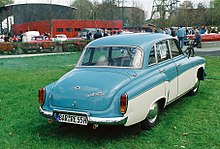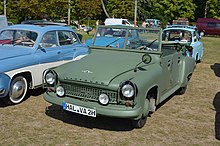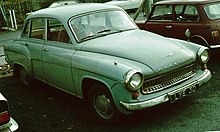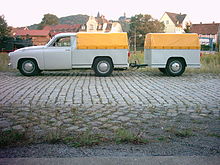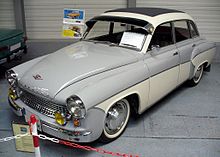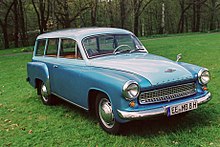War castle 311
| Wartburg | |
|---|---|
|
Wartburg 311 from 1963
|
|
| War castle 311 | |
| Sales designation: | War castle 311 |
| Production period: | 1955-1965 |
| Class : | Lower middle class |
| Body versions : | Limousine , station wagon , coupe , convertible , Kübelwagen , pickup |
| Engines: |
Petrol engines : 0.9–1.0 liters (27–37 kW) |
| Length: | 4300 mm |
| Width: | 1570 mm |
| Height: | 1450 mm |
| Wheelbase : | 2450 mm |
| Empty weight : | 960 kg, from 1961: 920 kg |
| Previous model | IFA F9 |
| successor | War castle 312 |


The Wartburg 311 was a car of the car plant Eisenach with three-cylinder - two-stroke engine , which was manufactured from 1955 to 1965. After the displacement was increased in 1962, the name Wartburg 1000 was added. Outwardly hardly changed, the vehicle was produced in a further developed variant as the Wartburg 312 until 1967 . The Wartburg 313 and the Wartburg 312-300 were derived as sporty variants . With its beautifully designed body , its functional design and variety of variants, the Wartburg 311 achieved more international recognition than any other car in the GDR . It also sold well in the non-socialist economic area and was therefore of great value for the GDR's foreign exchange procurement . The outdated, maintenance-intensive chassis, which was only replaced by a new development in the successor model 312, was considered a drawback. A total of 247,368 vehicles of the Wartburg 311 were produced.
Development history
As a former production site for BMW cars, the Eisenach automobile plant continued to produce larger cars with six - cylinder four-stroke engines after the Second World War . The government of the GDR decided in 1953 to relocate production of the significantly smaller IFA F9 with a three - cylinder two-stroke engine from Zwickau to Eisenach and thus to end the production of the EMW types that had previously been manufactured in Eisenach .
Without so-called “planning authorization”, the plant began, on its own responsibility, to develop, present and mass-produce a larger successor model with a four-door pontoon body based on the F9 . The plant received support from the very positive reactions in the press and public. This was still possible at the time, since the SED only consistently implemented its unconditional claim to leadership at the Eighth Party Congress in 1971. Operations director Martin Zimmermann was nevertheless given a disciplinary penalty of DM 5000 for the vehicle, which was regarded as a "black development". In principle, however, the government was open to a swift model change, since a lawsuit by Auto Union had been pending since 1955 , see IFA F9 . A pilot series of 162 vehicles was built in October 1955, and series production began in January 1956.
The new, larger body on the 100 mm longer frame of the F9 with a large trunk and space for five people made it necessary to increase the engine power. Extensive change measures, which also included a redesign of the combustion chamber, resulted in an increase in output of 5 hp and a maximum torque of 8.3 kpm, which was already reached at 2200 rpm and gave the Wartburg a certain liveliness. The reinforced rear axle with telescopic shock absorbers was also new . The large, curved windows at the front and rear based on the principle of a full-view body received special mention . However, the new, elegant body could not hide the fact that the frame construction retained a relatively high weight and that the unchanged maintenance-intensive chassis was no longer up-to-date.
The designation 311, like the following (313, 312, 353 and prototypes), is in BMW tradition - all BMWs and EMWs manufactured in Eisenach had three-digit numbers, all of which began with a "3"; the F9 was listed in Eisenach as "EMW 309". The Wartburg was also known internally as EMW 311 until 1955 . The trade name chosen was the name of the first motor vehicle produced by Eisenacher Fahrzeugwerke in 1898 , ultimately based on the Wartburg in Eisenach .
Facelift
The frame construction allowed the Wartburg 311 to be implemented with different bodies without difficulty, resulting in an unusually large variety of variants (see model range ). The most important technical changes during the construction period were the gearbox , which was synchronized from 1958 with the exception of the first gear, and the engine, which was boosted to 40 hp in 1961, followed by an engine bored to 992 cm³ in 1962, which now produced 45 hp. Initially, vehicles with the larger engine were referred to as Wartburg 312 , but they soon switched to Wartburg 1000 . The designation 312 was limited to the engine itself, but was used again for the Wartburg 312 from 1965 .
Externally, the radiator grille, which was modified at the end of 1958 and was similar to that of the 313, is striking. At the same time, the brakes were improved, including now duplex brakes on the front wheels. From the end of 1959, somewhat softer leaf springs were used and the steering became smoother. Among other things, the Wartburg now had asymmetrical dipped beam and the previously cumbersome locking of the tank lid was greatly simplified. In addition, the central lubrication had been abandoned due to a lack of functional reliability, which tended to increase the maintenance effort of the outdated chassis. In 1962 a sophisticated fresh-air heating system was introduced. After the manufacturing quality of the Wartburg had previously been recognized with the S quality mark , the 1000 cm³ engine introduced in 1962 received the Q quality mark for top quality, as it is particularly qualitatively superior to the West German two-stroke engines from Auto Union ; After a mileage of 100,000 km, only the slightest complaints were found. The engine of the Wartburg 1000 was also used in the Barkas B 1000 pickup truck and at times in Syrena , Poland . With the larger motor, the thermosiphon cooling was replaced by conventional pump circulation cooling . Furthermore, a newly developed intake silencer was used so that the intake noises were no longer audible when driving. The 1963 model attracted attention from the outside due to its modified taillights, and it also had a windscreen washer system, new seats and attachment points for front belts. The improvements in 1964 included a double cardan shaft , a needle bearing for the upper connecting rod bearing, more elastic engine mounts and automatic brake adjustment.
Some changes could not be carried out in series: At the Leipzig autumn fair in 1958, the Wartburg was shown with an elaborately designed bumper. On the engine of the Wartburg 311, tests were carried out on the use of gasoline injection with positive results, but the carburettor engine remained in series production .
Model range
311/0 standard sedan
This type made up the bulk of production with 130,411 copies made. It was mostly painted in one color or available with a color-contrasting roof. Production began in 1955 and ended in 1965.
311/1 luxury sedan
The luxury sedan had a number of additional equipment details. Outwardly, it was noticeable by a two-tone paintwork with chrome strips, the design of which changed several times during the construction period. Other distinguishing features from the standard sedan were decorative rings on the running wheels, exhaust covers, decorative frames on the interior panels of the doors, door pull handles designed as armrests, cover strips on the windows, special design of the dashboard, high-quality wool upholstery and velor flooring, adjustable backrests, etc. From 1957 to 55,660 vehicles were built in 1965.
311/2 convertible
The convertible was designed with two doors and four seats. The luxurious cars with real leather fittings were built in the VEB Karosseriewerk Dresden . From 1956 to 1960, 2,670 vehicles were produced. Production had to be discontinued in favor of the 311/3, which previously came from the Meerane bodywork . In the following years there was no open variant in the program. The gap in the supply was temporarily closed again with the 312-300 HT type .
311/3 Coupé
The Wartburg 311 was manufactured as a coupé by the Meerane bodywork from 1957, initially in an elaborate three-color paint scheme with straight trims. In 1959, production of the coupé was relocated to Dresden in favor of manufacturing the Trabant P 50 Universal . This was followed by a new design in a curved two-tone paintwork, which is considered to be very harmonious and particularly accentuates the already successful body shape. The large panoramic rear window was only made in one piece in the first few years. In 1963, a new paint cycle line was introduced in the bodywork factory in Dresden, which now also enabled synthetic resin paint (previously nitro paint ) for the camping and coupé bodies produced there . By 1965, 5,487 coupes were produced.
311/4 police emergency vehicle (Kübelwagen)
The vehicle corresponds to a cabriolet in bucket construction . It remained a marginal phenomenon, 791 units were built between 1959 and 1964.
311/5 Camping limousine, with folding roof
Contrary to the name of the car manufactured in the bodywork in Dresden , this was a four-door station wagon that was particularly luxurious. The term camping limousine was obviously intended to avoid the impression that it was a commercial vehicle - because station wagons were nothing else according to the understanding of the time. With a large folding sunroof, panoramic windows on the side and seats that can be converted into a straight lying surface, the term camping didn't promise too much. Similar to the 311/3, the panorama panes soon had to give way to split panes. In 1963, a new paint cycle line was introduced in the bodywork factory in Dresden, which now also enabled synthetic resin paint (previously nitro paint ) for the camping and coupé bodies produced there . While the first owners mostly used the campsite in the intended sense, the vehicles were used in the second and third hand for pure transport purposes. The two-tone paintwork in its original form met with a split response, but the later version was considered very successful. 8,362 vehicles were produced from 1956 to 1965. Ultimately, the campings were more cared for than the station wagons, and after the wear limit was reached, station wagons were often rebuilt with replacement camping bodies, because these were still produced as spare parts for a long time. So it happens that the 311/9 are much rarer today than the 311/5, although the former were produced on a larger scale.
311/6 sedan, right-hand drive
This version was built 737 times between 1961 and 1964 for export markets with left-hand traffic.
311/7 express transport vehicle (pickup)
This pickup version of the Wartburg 311 comes from VEB Karosseriewerke Halle . It was intended to help alleviate the acute shortage of vans in the GDR. In the first few years up to 1960, however, only 95 units were built. A harmonious round tail is characteristic of this extremely rare Wartburg variant. 1961–1965, the pickups were built in relevant numbers, with the round tail giving way to a less harmonious angular structure. However, matching trailers were also supplied. Some of the vehicles had a fabric roof. A total of 4938 vehicles had been built by 1965.
311/8 folding roof sedan
Both the standard sedan and the luxury sedan were offered as 311/008 and 311/108 with a large folding sunroof. This variant is very popular today among classic car enthusiasts. In 1964 a steel sliding roof was used. This no longer offered such a large opening, the advantages were increased security and easier operation and maintenance. Of these, 14,749 vehicles were built in the period 1956–1965.
311/9 combi
As a pure transport vehicle, the Wartburg 311 was manufactured in the Halle bodywork as early as 1955 as a two-door station wagon. The vehicle had a wooden structure, initially with a plastic roof. In 1964, the rear end was straightened and a rear door that opened upwards instead of to the side was installed, which allowed a larger loading opening. In addition to delivery vans and standard models, this station wagon was also available in a luxury version with two-tone paintwork and upgraded interior fittings. The filler neck for refueling was now on the side, with earlier station wagons the fuel did not always flow unrestrained into the tank. The rear leaf spring was reinforced in the station wagon, and the translation was changed to improve the tractive effort, which resulted in a lower top speed of officially 100 or 105 km / h with the 1000 engine. Although 23,568 units were built between 1955 and 1965, the station wagon is now almost gone.
313/1 sports car
War castle 312
Prototypes
- 311 / x Bellevue two-door
- 311 Cabriolet from the Dresden body shop with panoramic window
- 311/1000 sliding door combination
- 313/2 sports coupe two-door
- 314 P100 notchback four-door sedan
distribution
Not least because of the low availability of new cars in the GDR , but also because of the repair-friendly frame construction, relatively few Wartburg 311s were scrapped. Often they were either mothballed or rebuilt after reaching the wear limit. Just under 180,000 Wartburg 311/312 were sold in Germany; 127,000 of these were registered in 1985. Abroad, the Wartburg 311 was not only present in Hungary, but also in Finland, which belongs to the NSW, and in 1963 the ten thousandth Wartburg was sold there.
Technical specifications
| Technical data: Wartburg 311, Wartburg 1000, Wartburg 313 (Sport) | |||
| War castle 311 | 1955 | 1961 | from 1962 ("Wartburg 1000") |
|---|---|---|---|
| Engine: | Three-cylinder two-stroke carburetor engine with reverse scavenging | ||
| Displacement: | 900 cc | 992 cc | |
| Drilling: | 70 mm | 73.5 mm | |
| Hub: | 78 mm | ||
| Compression: | 1: 6.6 to 6.8 | 1: 7.3 to 7.5 | 1: 7.3 to 7.5 |
| Power: | 27 kW (37 hp) at 4000 min -1 | 29 kW (40 hp) at 4000 min -1 Sport-313 37 kW (50 HP) |
33 kW (45 hp) at 4250 min -1 |
| Max. Torque: | 81 Nm (8.3 mkp) at 2200 min -1 | 83 Nm (8.5 mkp) at 2200 min -1 | 93 Nm (9.5 mkp) at 2200 min -1 |
| Timing: - inlet opens - flushing opens - outlet opens |
57 ° before TDC 54 ° 50 'before UT 75 ° 10' before UT |
||
| Fuel octane number: | 2-stroke mixture VK 72 | 2-stroke mixture VK 79 | |
| Oil to be used: | Two-stroke oil | ||
| Lubrication: | Fresh oil mixture lubrication | ||
| Cooling: | Water ( thermosiphon cooling with fan wheel) | Water cooling | |
| Mixing ratio: | 1:25 | 1:33 1/3 for 313 always 1:25 |
1:33 1/3 |
| Shape of the combustion chamber | cylindrical with swirl edge on the exhaust side | kidney-shaped with a double eddy edge | cylindrical with concentric eddy edge |
| Top speed: | 115 km / h Kombi: 100 km / h Sport: 140 km / h |
125 km / h station wagon: 105 km / h |
|
| Average consumption: | 9.8 l / 100 km | 9.7 l / 100 km | 9.5 l / 100 km |
| Carburetor: | VEB Berlin carburetor factory , Berlin (Wartburg-Sport 2 × H362-1) |
||
| Type: | BVF H 362-5 | BVF H 362-18 | BVF H 362-20 |
| Transmission: | unsynchronized until January 1958 | Block transmission four-speed gear transmission, partly synchronized (2nd, 3rd and 4th gear) |
|
| Freewheel: | Can be locked manually in all forward gears, automatic lock in reverse | ||
| Coupling: | Single-disc dry clutch with 6 compression springs, completely encapsulated | ||
| Front axle: | Independent wheel suspension, does not change the camber, suspended from the transverse leaf spring at the top, from the wishbone at the bottom without an axle | ||
| Rear axle: | Rigid axle with trailing arms and high transverse leaf spring | ||
| Drive: | Hinge cardan shafts with front-wheel drive joints | From April 30, 1964, double cardan shafts with front-wheel drive joints | |
| Chassis lubrication: | Central lubrication with pump from VEB Landmaschinenbau Falkensee | Lubrication points for grease gun | |
| Rims: | 4J × 15 "(Combi: 4½K × 15") | ||
| Tires: | 5.90-15 (Combined: 6.4-15) | ||
| Ground clearance (loaded): | 190 mm | ||
| Brakes: | front + rear simplex, brake pad width 35 mm | hydraulic inner shoe brake; front duplex, rear simplex sliding shoe brakes, brake lining width 50mm | |
| Accumulator: | 6 V | ||
| Ignition system: | 1 ignition interrupter and 1 ignition coil per cylinder | ||
| Electrical system (type 311, 313 built in 1957): | DC generator 6 V 180 W from 2200 rpm | ||
| Headlights: | 200 mm light emission | 170 mm light emission | |
| Dimensions (L / W / H): | 4300/1520/1450 mm (sedan, convertible) 4210/1570/1450 mm (coupé, camping) |
||
| Weights: total weight empty / useful weight / total load: |
Sedan: 920 kg / 380 kg / 1300 kg Cabriolet, Coupé: 985 kg / 340 kg / 1325 kg |
||
Review
In 1959, the Wartburg 311 sedan was tested by the automotive engineering magazine . The low center of gravity and the generally very direct driving behavior were emphasized. The elegantly shaped car has become more attractive thanks to the new grill and the glossy synthetic resin paint. The too hard suspension of the leaf springs in view of the poor road conditions and the poor quality of the wiper blades were criticized. In addition, the dead weight, which is quite large in international comparison, was warned. In addition, the engine noises in the passenger compartment were too loud, the seats in the standard version were perceived as tiring, and the brakes had a tendency to overheat and squeal.
In the winter of 1962/1963, the KFT tested the Wartburg 1000 in severe frost, whereby good starting behavior, however, inadequate heating output and too long a warm-up phase of the engine with the now pump circulation cooling was found. The characteristics of the 45 hp engine and the driving behavior were judged positively, while the high curb weight, the large turning circle and the suspension that was too hard were criticized again.
When testing the 311/9 de Luxe in 1964, it was added that the pedal forces for the clutch and brakes on the Wartburg were generally too high. Concerning the station wagon, a tendency for the front wheels to spin when starting up on inclines and a somewhat greater tendency to oversteer than with the sedan was found, and the problem of the rear window quickly becoming dirty was not solved. As a result of the changed gear ratio, a more lazy driving style is possible and full payload is hardly noticeable on the drive side. The maximum speed was set at 112 km / h and an average fuel consumption of 9.9 l / 100 km was determined.
Motorsport
The Wartburg 311 was also successful in motorsport at the time. Among other things, Kurt Otto achieved overall victory in the Hanseat Rally at the Nürburgring in 1959 . With the larger engine (Wartburg 1000), the first class victory was achieved at the Semperit rally in Austria in 1962. In the same year, the class win in the Alpine race and the Bulgaria Rally followed .
literature
- Michael Stück: Wartburg 311. TIM Verlag, Berlin 1999, ISBN 3-933451-04-3 .
- Wartburg type - a new car from Eisenach. In: Motor Vehicle Technology 2/1956, pp. 55–58.
- Carburettor problems with the two-stroke engine, 2) AWE 311 Wartburg. In: Motor Vehicle Technology 4/1958, pp. 128-133.
- Frank Rönicke: Wartburg 311/313/1000. Motorbuch Verlag, Stuttgart 2014, ISBN 978-3-613-03630-7 .
Web links
Individual evidence
- ↑ Trabant and Wartburg improved . In: Motor vehicle technology 05/1961, p. 197.
- ↑ Wartburg won the beauty pageant. In: Motor vehicle technology 1/1959, p. 36
- ↑ Wartburg tested in France. In: Motor vehicle technology 7/1958, p. 242.
- ^ Peter Kirchberg: Plastics, sheet metal and planned economy . Nicolai-Verlag, Berlin 2000, ISBN 3-87584-027-5 .
- ↑ KFT Motor Vehicle Technology , February 1956 edition, reproduced here , accessed on October 21, 2015
- ↑ 309 spare part numbers, for example on gearboxes from the early years of construction of the 311
- ↑ Wartburg synchromesh gear . In: Motor vehicle technology 1/1959, p. 21.
- ^ The "Wartburg" model 1962. In: Motor vehicle technology 3/1962, pp. 94-100 + cover picture.
- ^ Nationally owned vehicle construction at the Leipzig spring fair. In: Motor vehicle technology 3/1959, p. 112.
- ↑ state-owned motor vehicle at the Leipzig Spring Fair 1960. In: Automotive Engineering 3/1960, pp 99,100.
- ^ The "Wartburg" model 1962. In: Motor vehicle technology 3/1962, pp. 94-100 + cover picture.
- ↑ Quality mark "Q" for Wartburg engine. In Automobiltechnik 9/1962 , p. 386.
- ↑ New filter with intake silencer in "Wartburg" 1962. In: Motor vehicle technology 5/1962, pp. 208–209.
- ^ Improvements to the Wartburg for 1963. In: Motor vehicle technology 2/1963, pp. 64–65.
- ↑ The "Wartburg 1000" 1964. In: Motor vehicle technology 3/1964, pp. 109–110.
- ↑ A comparison. In: Motor vehicle technology 9/1958, p. 323.
- ↑ Investigations on two-stroke gasoline engines with gasoline injection. In: Motor Vehicle Technology 10/1958, pp. 370–373 and 11/1958, pp. 416–421.
- ↑ Development trends in the field of fuel injection for gasoline engines. In: Motor Vehicle Technology 4/1959, pp. 145–148.
- ↑ Attempts to influence the air conditions in the Wartburg engine. In: Motor vehicle technology 10/1960, pp. 388–391.
- ↑ a b c d e f g h i j Michael Stück: Wartburg 311. TIM Verlag, Berlin 1999, ISBN 3-933451-04-3 , p. 99.
- ↑ a b The nationally owned vehicle construction at the Leipzig spring fair 1958. In: Motor vehicle technology 3/1958, pp. 95–98.
- ↑ Lacktaktstrasse for the Wartburg-Camping. In: Automotive Technology. 8/1963, pp. 296-297.
- ↑ Lacktaktstrasse for the Wartburg-Camping. In: Automotive Technology. 8/1963, pp. 296-297.
- ↑ The "Wartburg 1000" 1964. In: Motor vehicle technology 3/1964, pp. 109–110.
- ↑ Improved superstructures from the Halle body shop. In: Motor Vehicle Technology 3/1964, pp. 107-108.
- ↑ Automotive technology assesses the Wartburg 1000 Kombi de Luxe. In: Automotive Technology . 6/1964, pp. 228-229.
- ↑ Leipzig Motor Show. in: Motor vehicle technology 5/1957, p. 177.
- ^ Peter Kirchberg: Plastics, sheet metal and planned economy. Nicolai-Verlag, Berlin 2000, pp. 716, 725
- ↑ Test: AWE 311 - Wartburg 1959. In: Motor vehicle technology 8/1963, p. 316.
- ↑ Test: AWE 311 - Wartburg 1959. In: Motor vehicle technology 11/1959, pp. 454–456.
- ^ Motor vehicle technology erprobte Wartburg 10000. In: Motor vehicle technology 3/1963, pp. 105-107.
- ↑ Automotive technology assesses the Wartburg 1000 Kombi de Luxe. In: Automotive Technology . 6/1964, pp. 228-229.
- ↑ Victory in the international Semperit rally! In: Motor vehicle technology 8/1962, p. 348.
- ↑ Great successes on Wartburg 312 at the Bulgaria rally and the Austria-Alpenfahrt. In: Motor vehicle technology 9/1962, p. 384.



